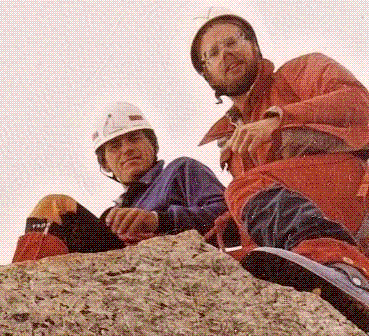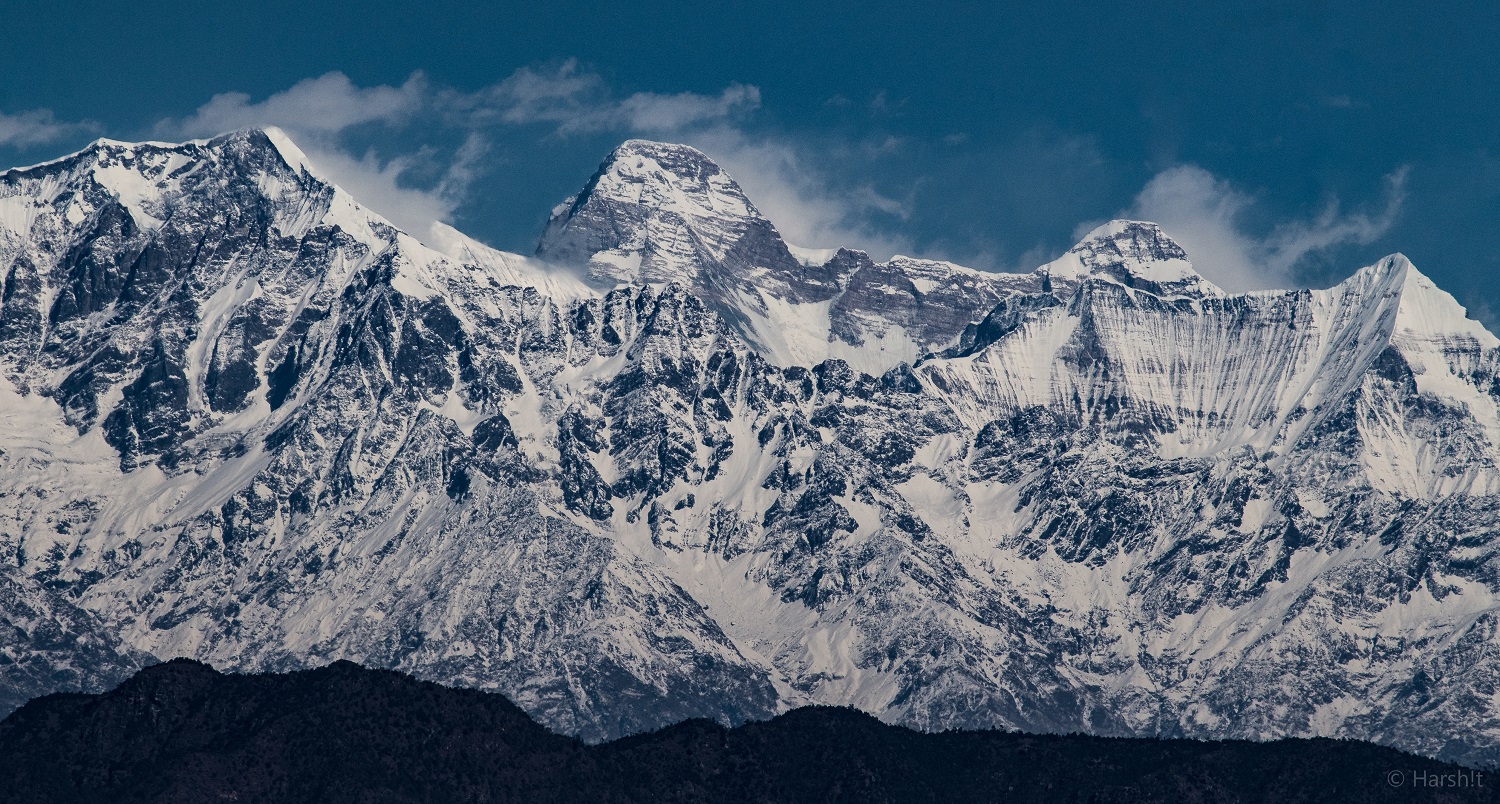|
Roger Payne (mountaineer)
Roger Payne (16 July 1956 – 12 July 2012) was a British mountaineer. He was formerly general secretary of the British Mountaineering Council (BMC) and a qualified mountain guide from 1983, taking part in over 20 expeditions to the Karakoram and Himalayan ranges, including K2 and the north face of Changabang. He was an avalanche instructor and climbed in the Alps every year from 1977. Biography Payne grew up in Hammersmith, London, and took an education degree in 1983 at Sunderland Polytechnic where he was president of the mountaineering club. He then became a teacher and climbing instructor and he later moved to Leysin, Switzerland. Payne was president of the British Mountain Guides Association and, after his death, was given honorary membership of the International Federation of Mountain Guide Associations (IFMGA) Death Payne was killed aged 55 with eight other climbers by an avalanche whilst traversing Mont Maudit, on the Mont Blanc massif, near Chamonix in the French A ... [...More Info...] [...Related Items...] OR: [Wikipedia] [Google] [Baidu] |
Mountaineering
Mountaineering or alpinism, is a set of outdoor activities that involves ascending tall mountains. Mountaineering-related activities include traditional outdoor climbing, skiing, and traversing via ferratas. Indoor climbing, sport climbing, and bouldering are also considered variants of mountaineering by some. Unlike most sports, mountaineering lacks widely applied formal rules, regulations, and governance; mountaineers adhere to a large variety of techniques and philosophies when climbing mountains. Numerous local alpine clubs support mountaineers by hosting resources and social activities. A federation of alpine clubs, the International Climbing and Mountaineering Federation (UIAA), is the International Olympic Committee-recognized world organization for mountaineering and climbing. The consequences of mountaineering on the natural environment can be seen in terms of individual components of the environment (land relief, soil, vegetation, fauna, and landscape) and locat ... [...More Info...] [...Related Items...] OR: [Wikipedia] [Google] [Baidu] |
UIAGM
The ''Union Internationale des Associations de Guides de Montagnes'' is the International Federation of Mountain Guides Associations, known alternatively by its French, German and English English usually refers to: * English language * English people English may also refer to: Peoples, culture, and language * ''English'', an adjective for something of, from, or related to England ** English national id ... abbreviations: * UIAGM, Union Internationale des Associations de Guides de Montagnes (French) * IVBV, Internationale Vereinigung der Bergführerverbande (German) * IFMGA, International Federation of Mountain Guide Associations (English) History In 1965 in Zermatt (Switzerland) representatives of the mountain guides associations from Italy, France, Austria and Switzerland decided to lay the foundations for an international federation of all mountain guides associations. First statutes in 1966. The purposes of the federation are: * Adjustment of t ... [...More Info...] [...Related Items...] OR: [Wikipedia] [Google] [Baidu] |
Nanda Devi
Nanda Devi is the second-highest mountain in India, after Kangchenjunga, and the highest located entirely within the country (Kangchenjunga is on the border of India and Nepal). It is the 23rd-highest peak in the world. Nanda Devi was considered the highest mountain in the world before computations in 1808 proved Dhaulagiri to be higher. It was also the highest mountain in India until 1975, when Sikkim, an independent kingdom until 1948 and a protectorate of India thereafter, became a part of the Republic of India. It is located in Chamoli Garhwal district of Uttarakhand, between the Rishiganga valley on the west and the Goriganga valley on the east. The peak, whose name means "Bliss-Giving Goddess", is regarded as the patron goddess of the Garhwal and Kumaon Himalayas. In acknowledgment of its religious significance and for the protection of its fragile ecosystem, the Government of India declared the peak as well as the circle of high mountains surrounding it—the N ... [...More Info...] [...Related Items...] OR: [Wikipedia] [Google] [Baidu] |
Tirsuli
Tirsuli is a Himalayan mountain peak in the Pithoragarh district of Uttarakhand, India. It is part of the complex of mountains, including Tirsuli West, Hardeol, Dunagiri, Changabang, and Kalanka, which make up the northeast wall of the Nanda Devi Sanctuary, in the Garhwal Himalaya. It rises at the northern end of the Johar Valley, which drains into the Gori Ganga. This peak should not be confused with nearby Trisul, which is on the southwest side of the Sanctuary. In 1939, a serious attempt on this peak by the successful Polish expedition to Nanda Devi East was abandoned after a night avalanche buried leader Adam Karpinski and climber Stefan Bernadzikiewicz at Camp 3.Jill Neate, ''High Asia: An illustrated history of the 7000 metre peaks'', The Mountaineers, 1989, 0-89886-238-8, p. 89. Indian team led by Mohan Singh Kohli from Indian Mountaineering Foundation, under Ministry of Defence, Government of India tried an unsuccessful attempt to the peak in 1964. Another team led by ... [...More Info...] [...Related Items...] OR: [Wikipedia] [Google] [Baidu] |
Meru Peak
Meru Peak is a mountain located in the Garhwal Himalayas, in the state of Uttarakhand in India. The peak lies between Thalay Sagar and Shivling, and has some highly challenging routes. The name Meru likely originated from the Sanskrit word for "peak". The mountain was formerly the site of the world's highest BASE jump from a location on the surface of the Earth by Glenn Singleman and Heather Swan, from a height of , in June 2006, a record which has since been surpassed by Valery Rozov's 2013 jump from the North Face of Mount Everest. The mountain has three distinct peaks: southern (), central (), and northern (). The two higher peaks were climbed earlier than the harder central peak, which was first climbed in a 2001 solo ascent by Valery Babanov, twice by other teams in 2006, and for the first time along the "Shark's Fin" route in 2011. Shark's Fin route This 1400m route to Meru Central follows North East Pillar, over the "Shark's Fin", a massive granite feature on t ... [...More Info...] [...Related Items...] OR: [Wikipedia] [Google] [Baidu] |
Pumari Chhish
Pumari Chhish ( ur, ), (or Pumarikish, Peak 11) is a high peak in the Shimshal, Shimshal Valley, a village of the Karakoram mountain range, range. It lies about 4 km east of Khunyang Chhish, in the heart of the Hispar, north of the Hispar Glacier. Pumari Chhish was first attempted by an Austrian group in 1974, who failed to climb or bypass the Yazghil Glacier on the north side of the peak. In 1979, a Japanese group from the Hokkaido Alpine Association and Pakistani Army officer of 29 signal succeeded in climbing the mountain via a long route starting from the Khunyang Glacier, well to the west of the peak. They first had to cross a significant mountain pass, col to access the upper Yazghil Glacier; they then ascended the north ridge of Pumari Chhish. According to the Himalayan Index, there have been no other successful ascents of Pumari Chhish. Pumari Chhish South About to the southeast of the main summit of Pumari Chhish lies Pumari Chhish South, .Jerzy Wala, ''Orograph ... [...More Info...] [...Related Items...] OR: [Wikipedia] [Google] [Baidu] |
Island Peak
Imja Tse, better known as Island Peak, is a mountain in Sagarmatha National Park of the Himalayas of eastern Nepal. The peak was named Island Peak in 1953 by members of the British Mount Everest expedition because it appears as an island in a sea of ice when viewed from Dingboche. The peak was later renamed in 1983 to Imja Tse but Island Peak remains the popular choice. The peak is actually an extension of the ridge coming down off the south end of Lhotse Shar. The southwest summit of Imja Tse was first climbed in 1953 as part of a training exercise by a British expedition that went on to summit Mount Everest. The team who climbed Imja Tse comprised Tenzing Norgay, Charles Evans, Alfred Gregory, Charles Wylie and seven other Sherpas. The main summit was first climbed in 1956 by Hans-Rudolf Von Gunten and two unknown Sherpas, members of a Swiss team that went on to make the second ascent of Everest and first ascent of Lhotse. Climbing route To climb Island Peak, one has ... [...More Info...] [...Related Items...] OR: [Wikipedia] [Google] [Baidu] |
Chomolhari
Jomolhari or Chomolhari (; ) sometimes known as "the bride of Kangchenjunga”, is a mountain in the Himalayas, straddling the border between Yadong County of Tibet, China China, officially the People's Republic of China (PRC), is a country in East Asia. It is the world's most populous country, with a population exceeding 1.4 billion, slightly ahead of India. China spans the equivalent of five time zones and ... and the Paro district of Bhutan. The north face rises over above the barren plains. The mountain is the source of the Paro Chu (Paro river) which flows from the south side and the Amo Chu which flows from the north side. Religious significance The mountain is sacred to Tibetan Buddhists who believe it is the abode of one of the Five Tsheringma Sisters; ''(jo mo tshe ring mched lnga)'' — female protector goddesses (Jomo) of Tibet and Bhutan, who were bound under oath by Padmasambhava to protect the land, the Buddhist faith and the local people. On the ... [...More Info...] [...Related Items...] OR: [Wikipedia] [Google] [Baidu] |
Eagle Peak (Chombu) , in the Selkirk Mountains of British Co ...
Eagle Peak is the name of 44 mountain peaks of the United States including: * Eagle Peak (Alaska) * Eagle Peak (Admiralty Island), in Alaska *Eagle Peak (Washington), a summit in Mount Rainier National Park *Eagle Peak (Mariposa County, California), a rock formation in Yosemite National Park *Eagle Peak (Modoc County, California), part of the Warner Mountains *Eagle Peak (Mono County, California), a mountain in the Sierra Nevada * Eagle Peak (San Bernardino County, California), tallest in the Sacramento Mountains, California * Eagle Peak (San Diego County, California) * Eagle Peak (New Mexico) *Eagle Peak (Wyoming) * Eagle Peak in Mineral County, Montana Eagle Peak in Canada: *Eagle Peak Eagle Peak is the name of 44 mountain peaks of the United States including: * Eagle Peak (Alaska) * Eagle Peak (Admiralty Island), in Alaska *Eagle Peak (Washington), a summit in Mount Rainier National Park *Eagle Peak (Mariposa County, California), ... [...More Info...] [...Related Items...] OR: [Wikipedia] [Google] [Baidu] |
French Alps
The French Alps are the portions of the Alps mountain range that stand within France, located in the Auvergne-Rhône-Alpes and Provence-Alpes-Côte d'Azur regions. While some of the ranges of the French Alps are entirely in France, others, such as the Mont Blanc massif, are shared with Switzerland and Italy. At , Mont Blanc (Italian: ''Monte Bianco''), on the France–Italy border, is the highest mountain in the Alps, and the highest Western European mountain. Notable towns in the French Alps include Grenoble, Chamonix, Annecy, Chambéry, Évian-les-Bains and Albertville. Ranges and summits Ski areas The largest connected ski areas are: # Les Trois Vallées ( Courchevel, Méribel, La Tania, Brides-les-Bains, Saint-Martin-de-Belleville, Les Menuires, Val Thorens and Orelle): 338 slopes, 600 km of pistes. # Portes du Soleil (Avoriaz, Châtel, Morzine, Les Gets, Saint-Jean d'Aulps, La Chapelle d'Abondance, Abondance, Montriond, Swiss resorts): 288 sl ... [...More Info...] [...Related Items...] OR: [Wikipedia] [Google] [Baidu] |
Chamonix
Chamonix-Mont-Blanc ( frp, Chamôni), more commonly known as Chamonix, is a commune in the Haute-Savoie department in the Auvergne-Rhône-Alpes region of southeastern France. It was the site of the first Winter Olympics in 1924. In 2019, it had a population of 8,640. Situated to the north of Mont Blanc, between the peaks of the Aiguilles Rouges and the notable Aiguille du Midi, Chamonix is one of the oldest ski resorts in France. The Chamonix commune is popular with skiers and mountain enthusiasts. Via the cable car lift to the Aiguille du Midi it is possible to access the off-piste ( backcountry) ski run of the ''Vallée Blanche''. Name The name Campum munitum, meaning fortified plain or field, had been used as early as 1091. By 1283 the name had been abbreviated to a similar form to the modern Chamonis. Other forms through the ages include Chamouny in 1581, Chamony in 1652, Chamouni in 1786, and the particular spelling Chamonix from 1793. Status Chamonix is the fourth-lar ... [...More Info...] [...Related Items...] OR: [Wikipedia] [Google] [Baidu] |






